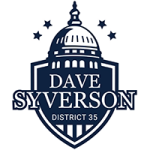SPRINGFIELD – Positive progress continued this week when Gov. Bruce Rauner signed into law an appropriations bill that funds higher education and MAP grants for college students through September. State Senator Dave Syverson (R-Rockford) indicated this is a positive sign of bipartisan compromise, and is a step in the right direction.
Also this week, it is now up to the Illinois Labor Relations Board to rule whether contract negotiations between Gov. Rauner and one of the state’s largest labor unions have truly reached an impasse.
Sadly, a report from data provider CoreLogic ranks Illinois number one in the nation for the highest median property tax rates. The new report was timely, coinciding with this year’s “Tax Freedom Day,” which falls on April 29.
On a positive note, The State Journal-Register reported that Lincoln’s Home in Springfield generated nearly $13.8 million for the capital city economy, just one example of the economic impact that Illinois historic sites have on local economies across the state.
A step in the right direction
On April 25, Gov. Bruce Rauner signed an appropriations bill providing funding for higher education and MAP grants. The bipartisan solution ensures that universities, colleges, and community colleges remain open through September, at which point they’ll start collecting their fall tuition money.
Gov. Rauner said this legislation doesn’t solve the budget crisis, but is a good step toward compromise between Democrat and Republican lawmakers. He noted it’s “time to build on the bipartisan momentum” and focus on passing a balanced budget for Fiscal Year 2016 and Fiscal Year 2017.
Comptroller Leslie Munger said her office would immediately start processing MAP grants and payments for the universities, colleges and for college student grants funded by the legislation.
The money provided in Senate Bill 2059 will come from the Education Assistance Fund. The state’s universities will split $356 million, community colleges will divide $74 million, and $169 million will go to students who had been waiting to receive MAP grants they were awarded to help them pay for school.
As the 11th month without a budget approaches, many social service programs are awaiting funding relief. Recently, the Senate passed bipartisan legislation that appropriates $441 million from the Commitment to Human Services Fund to help pay for critical human service programs. Senate Bill 2047 is currently pending in the House of Representatives.
Lawmakers return to the Capitol on May 3 to resume legislative action.
Rauner/AFSCME go to labor board over union contract negotiations
This week, the Illinois Labor Relations Board began a hearing on whether contract negotiations are at a standstill between Gov. Rauner and one of the state’s largest employee unions.
Having failed to negotiate a compromise agreement with the American Federation of State, County and Municipal Employees (AFSCME), the Governor referred the dispute to the state labor board in January in accordance with law. Now the Illinois Labor Relations Board will decide whether the parties have truly reached an “impasse.”
If the labor board determines the parties are unable to reach an agreement, Gov. Rauner could move forward with his last and best offer. Union members could either accept the Governor’s terms or go on strike. However, if the board decides that the two parties have not yet reached an impasse, the negotiations will continue.
Gov. Rauner and AFSCME had been negotiating for more than a year before the Governor went to the labor board in January. During negotiations AFSCME, which represents roughly 38,000 state workers, refused several contract offers presented by the Governor. These contracts were similar to ones agreed on by over a dozen other union locals.
At the heart of the dispute, are changes to worker raises, overtime hours, and health insurance costs. Gov. Rauner has said that AFSCME’s contract demands would cost more than $3 billion at a time when the state faces serious fiscal challenges.
The hearing began on April 25 and is expected to last through May before an administrative law judge issues a decision. Additionally, either party can appeal the decision, beginning a process that could add weeks or months to the impasse.
Illinois holds highest median property tax rate
Illinois has the highest median property tax rate in the nation, according to CoreLogic, a data provider to financial services and real estate companies. While the national median property tax rate is 1.31 percent, Illinois weighs in at a 2.67 percent.
Senate Republican lawmakers say these figures hit home for the people of Illinois. According to CoreLogic, a home valued at $200,000 will, on average, pay annual total property taxes of $2,620. However, in Illinois, that homeowner would pay $5,340.
The state’s high property taxes pose a tremendous financial burden for Illinois families and job creators, and play a significant role in the state’s high out-migration of both residents and businesses. Senate GOP lawmakers introduced legislation to provide property tax relief for hardworking Illinois families and businesses, while giving local governments the tools to reduce their costs. However, Democrat legislative leaders have not allowed the measure to advance for consideration by the Senate.
CoreLogic’s calculations include all taxing entities, which can include property taxes paid to a number of different entities. These include counties, villages and school districts.
Following Illinois, New York has the second highest median property tax rate at 2.53 percent. Hawaii has the lowest median property tax rate at .31 percent.
The CoreLogic findings come as no surprise—a recent study by the financial website WalletHub had determined Illinois has the second-highest property taxes in the nation.
One hundred nineteen days to tax freedom day
This year “Tax Freedom Day” in Illinois falls on April 29, meaning Illinois residents worked 119 days to pay off their total tax bill in 2016. The longer it takes the pay their taxes, means the less money taxpayers are taking home for food, clothing, housing and other necessities.
Tax Freedom Day underscores what Republican lawmakers have been saying for years—spending cuts coupled with systemic, structural reforms to reduce rampant abuse, fraud and waste are critically important. The longer it takes to implement these changes in how Illinois operates, the more businesses will continue to leave the state, the less money Illinoisans will have in their pockets and our Tax Freedom Day will just keep getting later.
The Washington, D.C.-based Tax Foundation adds up all of the federal, state and local taxes and then divides the number by the national income. The date when people earn enough collectively to pay off their yearly tax burdens has become known as “Tax Freedom Day.”
Historic sites generate state revenue
According to The State Journal-Register, a recent report from the National Park Service notes that $13.8 million were added to the capital city’s local economy in 2015 from visitors to the Lincoln Home Historic Site. There were a total of 233,296 visitors in 2015 alone. Local site attendance was up 18 percent, possibly due to it being the 100th anniversary of the park service, along with lower gas prices making for easier travel.
The Lincoln Home was the third most visited site in the Springfield area last year, behind Lincoln’s New Salem State Historic Site, which had about 358,000 visitors, and then the Abraham Lincoln Presidential Library and Museum, which drew more than 303,000 visitors.
The Lincoln historical sites are just a few of many sites in Illinois that help generate revenue. According to the Illinois Historic Preservation Agency, there are at least 56 historic sites in Illinois, ranging from U.S. Grant’s Home in the Northwest, the Douglas Tomb in the Northeast, the Dana Thomas House in Central Illinois, Cahokia Mounds in the Southwest, and the Lincoln Trail Memorial in the Southeast region.
Historic places stimulate revenue-generating tourism and traffic throughout Illinois. Senate Republicans on the Historic Preservation Caucus have driven recent efforts to highlight the importance of keeping these sites open, as lawmakers continue to work toward bipartisan solutions for the budget impasse.

